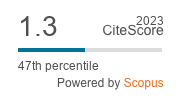The Social Effects Of The Economic Transformation In India (An Attempt At Measurement and Evaluation)
DOI:
https://doi.org/10.1515/cer-2017-0007Keywords:
Indian economy, economic development in India, social development in India, life expectancy in IndiaAbstract
One of significant and, at the same time, challenging research problems in Economics is measuring the social effect of economic growth (development). Economic growth should never be treated a goal per se. It is rational provided that it brings effects such as, generally speaking, an improvement in the standard of living. However, this is not always the case. Social sciences, including Economics, have not developed any uniform methods of measuring and evaluating such effects yet.
This paper constitutes an attempt to measure and evaluate the social effects of the reforms of the Indian economy and state launched in 1991. The analysis covers a period of over twenty years. As a result of the aforementioned reforms, at the beginning of the second decade of the 21st century, India ranked third in the world in terms of GDP (based on purchasing power parity), after the USA and China. So what are the social effects of such a dynamic economic growth?
For the purposes of this paper, in order to quantify and evaluate the social effects of the economic growth in India and its dynamics in the analysed time period, the author experimentally adopts a popular socio-demographic index, i.e. the average further life expectancy (e0). This constitutes the so-called natural aggregate (a micro index) applied in social development analyses. It is quite commonly used by Indian economists and statisticians, albeit it is rarely applied in European Economics.
The empirical analysis of the trends in the said index proves that the rapid economic growth in India after the year 1991 has brought about substantial increases in the life expectancy of the inhabitants of the country and a diminishing of disparities in this regard on a national scale (in different cross-sections: urban-rural, females-males, as well as in the regional perspective). In the mid-2010s India is almost on a par with the countries with a medium development rate in terms of the life expectancy of its inhabitants and in some states (e.g. Kerala). the value of this index is comparable to that in the highly developed countries.
Downloads
References
Acharya S., Ahluwalia I.J., Krishna K.L., Patnaik I. (2006), Economic Growth in India, 1950–2000, [in:] K.S. Parikh (ed.) Explaining Growth in South Asia, Oxford University Press, Delhi.
Google Scholar
Bywalec G. (2009), Decentralizacja Indii, przesłanki, istota i bariery, ʻSamorząd Terytorialnyʼ, no. 12.
Google Scholar
Bywalec G. (2010), Dynamika i determinanty rozwoju gospodarczego Indii, „Ekonomista”, no. 3.
Google Scholar
Bywalec G. (2013), Rozwój regionalny Indii po reformach z lat 1991–1992, ʻStudia Ekonomiczneʼ, no. 4 (LXXIX).
Google Scholar
Bywalec G. (2015), Reformy ekonomiczne i polityczne a rozwój gospodarczy Indii (1991–2012), Wydawnictwo Uniwersytetu Łódzkiego, Łódź.
Google Scholar
Census of India 2011. Provisional Population Totals (2011), Paper 1 of 2011, India Series 1, Office of the Register General & Census Commissioner, India, New Delhi.
Google Scholar
Datt G., Mahajan A. (2014), Datt & Sundharam Indian Economy, S. Chand & Company PVT.LTD, New Delhi.
Google Scholar
Das A. (1999), Socio-Economic Development in India: A Regional Analysis, “Development and Society”, vol. 28, no. 2, December.
Google Scholar
Drèze J., Sen A. (2013), An Uncertain Glory. India and Its Contradictions, Princeton University Press, Princeton-Oxford.
Google Scholar
Economic Survey 2015-2016, Statistical Appendix, (2016), Government of India, Ministry of Finance, Oxford University Press, New Delhi.
Google Scholar
Gedam R. (1999), Statistical Profile of India 1999, Deep & Deep Publication PVT LTD, New Delhi.
Google Scholar
Ghosh M. (2013), Liberalization, Growth and Regional Disparities in India, Springer, New Delhi – Heidelberg – New York – Dordrecht – London.
Google Scholar
Human Development Index (HDI) (2016), [in:] United Nations Development Programme. Human Development Reports, http://hdr.undp.org/en/content/human-development-index-hdi, (accessed 04.06. 2016).
Google Scholar
Indian Economy Since Independence. A Comprehensive and Critical Analysis of India’s economy, 26th Edition 2015–2106 (2015), [ed.] U. Kapila, Academic Foundation, New Delhi.
Google Scholar
Kulkarni P.M. (2014), Demographic Transition in India, [in:] http://www.censusindia.gov.in/2011Census/Presentation/Demographic-Transition-in-India.pdf. (accessed 10.06.2016).
Google Scholar
Łyszczarz B., Wyszkowska Z. (2013), Czynniki socjoekonomiczne i trwanie życia w krajach OECD (Socio-Economic Factors and Life Expectancy in OECD Countries), ʻNierówności społeczne a wzrost gospodarczyʼ, no. 30, pp. 53–61.
Google Scholar
OECD Data. Life Expectancy at Birth, [in:] https://data.oecd.org/healthstat/life-expectancy-at-birth.htm (accessed, 12.06.2016).
Google Scholar
Paz O. (1997), Podpatrywanie Indii, Wydawnictwo Literackie, Kraków.
Google Scholar
Ram F., Shekhar Ch., Mohanty S.K. (2005), Human Development: Strengthening District Level Vital Statistics in India, International Institute for Population Sciences (Deemed University), Mumbai.
Google Scholar
Ramachandran V.K. (1996), On Kerala’s Development Achievements, [in:] J. Drèze & A. Sen, Selected Regional Perspectives, Oxford University Press, New Delhi.
Google Scholar
Rocznik Statystyczny Rzeczypospolitej Polskiej 2015 (2016), Główny Urząd Statystyczny, Warszawa.
Google Scholar
Rosset E. (1959), Tablice wymieralności jako barometr postępu społecznego, ʻEkonomistaʼ, nr 4–5.
Google Scholar
Rosset E. (1979), Granice starzenia się społeczeństw, ʻKultura i Społeczeństwoʼ, nr 3.
Google Scholar
Selected Socio-Economic Statistics India (2011), Government of India, Ministry of Statistics and Programme Implementation Central Statistics Division, New Delhi.
Google Scholar
Sen A.K. The Concept of Development (2008), [in:] Ch. B. Barret [ed.], Development Economics. Critical Concepts in Development Studies, vol. 1, Routlegde. Taylor and Francis Group, London – New York.
Google Scholar
Downloads
Published
How to Cite
Issue
Section
License

This work is licensed under a Creative Commons Attribution-NonCommercial-NoDerivatives 4.0 International License.











